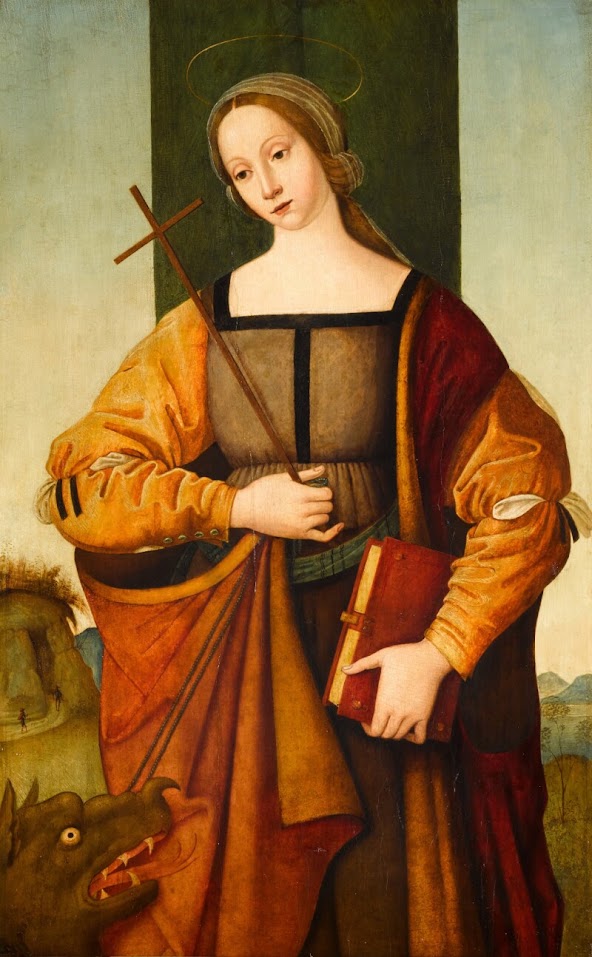Margaret Clitherow was born in 1556. Her father was a respected businessman. He died when Margaret was fourteen. She married John Clitherow, a wealthy butcher and a chamberlain of the city, in 1571 and bore him three children. The family lived in The Shambles.
Daphne Pollen, 1904–1986, was born into a wealthy family.
Daphne attended the Slade School of Art, and developed a particular gift as a muralist. By 1923, aged only nineteen, she was working on an immensely ambitious work; a sixty-foot mural of ‘Christ Healing the Sick’ in the church of All Hallows, Poplar. The church was badly damaged in 1942 during the Blitz, and was demolished in 1952, so this work has been lost.
However, also in 1923, she went with her family to India to see Lutyens’ work at New Delhi, and found a fellow Slade alumnus was also travelling on the boat: Arthur Pollen. They fell in love, and in 1926, she married him, and converted to Catholicism.
After her marriage, her practice as an artist declined as her domestic commitments increased, but such work as she did, like her husband’s, was focused on Christian themes, and Catholic church art in particular, though she was also a competent portraitist. ‘The Forty English Martyrs’ was painted in 1968. This was commissioned by the Society of Jesus at a time when Philip Caraman and John Walsh SJ were working towards the canonisation of the English martyrs.
The Pollens’ belief in the importance of religious art was transmitted to the next generation. Both their sons, the architect Francis Pollen (he designed Worth Abbey in Sussex) and the stained-glass artist Patrick Pollen, worked regularly on religious subjects throughout their respective careers. More on Daphne Pollen
She converted to Roman Catholicism in 1574. Although her husband belonged to the Established Church, he was supportive as his brother William was a Roman Catholic priest. He paid her fines for not attending church services. She was first imprisoned in 1577 for failing to attend church. Two more incarcerations at York Castle followed. Her third child, William, was born in prison.
Margaret risked her life by harbouring and maintaining priests, which was made a capital offence by the Jesuits, etc. Act 1584. Her home became one of the most important hiding places for fugitive priests in the north of England. Local tradition holds that she also housed her clerical guests in the Black Swan Inn at Peaseholme Green, where the Queen's agents were lodged.
In March 1586 the Clitherow house was searched. A frightened boy revealed the location of the priest hole.
Jacob Neefs or Jacob Neeffs (Antwerp, 1610 – Antwerp, after 1660) was a Flemish etcher, engraver and publisher. He worked on publication projects for prominent Flemish artists of his time including Rubens, van Dyck and Jordaens.
Jacob Neefs was a pupil of Lucas Vorsterman the Elder. In 1632-3 he was admitted as a master in the Guild of Saint Luke of Antwerp. In March 1632 he became a member of the 'Sodaliteit van de Bejaerde Jongmans', a fraternity for bachelors established by the Jesuit order. He married Anne Antonissen on 5 February 1655. He is last mentioned in the registers of the Guild of Saint Luke in 1661. More on Jacob Neeffs
Margaret was arrested and called before the York assizes for the crime of harbouring Roman Catholic priests. She refused to plead, thereby preventing a trial that would entail her three children being made to testify, and being subjected to torture. Although pregnant with her fourth child, she was executed on Lady Day, 1586, by being crushed to death by her own door, the standard inducement to force a plea.
The two sergeants who should have carried out the execution hired four desperate beggars to do it instead. She was stripped and had a handkerchief tied across her face then laid across a sharp rock the size of a man's fist, the door from her own house was put on top of her and loaded with an immense weight of rocks and stones so that the sharp rock would break her back. Her death occurred within fifteen minutes, but her body was left for six hours before the weight was removed. More on Margaret Clitherow
Please visit my other blogs: Art Collector, Mythology, Marine Art, Portrait of a Lady, The Orientalist, Art of the Nude and The Canals of Venice, Middle East Artists, 365 Saints and 365 Days, also visit my Boards on Pinterest
Images are copyright of their respective owners, assignees or others.
Some Images may be subject to copyright
I don't own any of these images - credit is always given when due unless
it is unknown to me. if I post your images without your permission, please tell
me.
I do not sell art, art prints, framed posters or reproductions. Ads are
shown only to compensate the hosting expenses.
If you enjoyed this post, please share with friends and family.
Thank you for visiting my blog and also for liking its posts and pages.
Please note that the content of this post primarily consists of articles
available from Wikipedia or other free sources online.






No comments:
Post a Comment
Note: Only a member of this blog may post a comment.